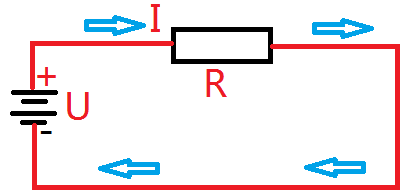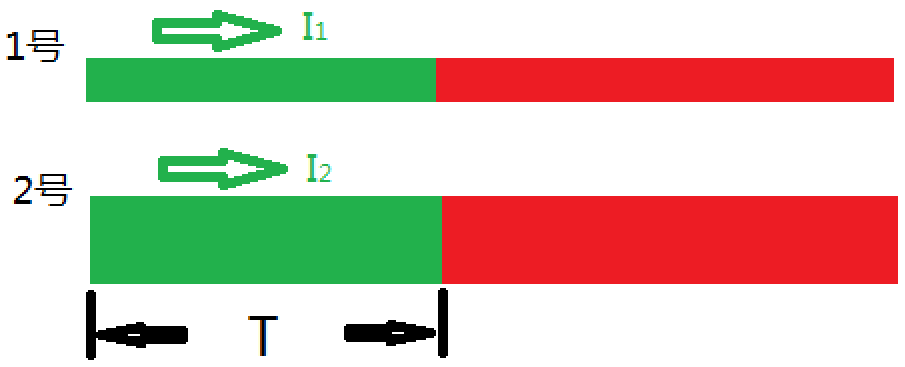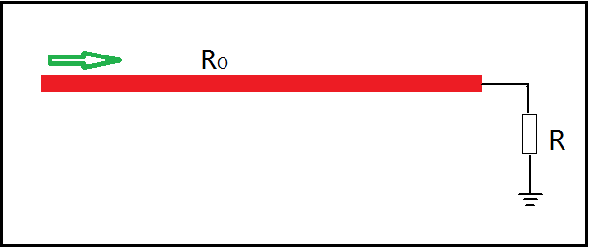Resistance is a real physical component. Through Ohm's law we can know the relationship between voltage, current and resistance, U=I*R
We analyze the specific relationship between these three through a specific circuit, please see the simplest circuit diagram below. This circuit diagram consists of only a power supply, a resistor and some wires.

Of course, the resistance of this resistor can also be directly measured with a multimeter.
The characteristic impedance is different. When measuring a 50 ohm characteristic impedance with a multimeter, it will be found to be a short circuit. This requires us to conceptually distinguish resistance (even if it is exactly 50 ohm resistance) and characteristic impedance are two different things. Like the degree of temperature (Celsius) and the degree of angle, it is not one thing.
Everyone knows the physical quantity of resistance, so I won't explain it here. Let's analyze what is the sacred characteristic impedance, and under what conditions will this thing be used.
In fact, the characteristic impedance is a physical quantity that is closely separated from the radio frequency. Before understanding the characteristic impedance, first understand the radio frequency. We know that radio stations, mobile phone communication signals, wifi, etc. are all devices that transmit signal energy to the outside. That is to say, the energy is shot out from the antenna, and the energy does not return to the antenna. I won’t come back when I go out.
Well, after we understand the radio frequency, we will come to the specific wire that transmits radio frequency energy. The RF signal transmitted on the wire is also the same. I hope that it will not be transmitted back in the past. If there is energy back in the back, the transmission effect is poor.
In order to explain the characteristic impedance more specifically, let me make an analogy here:
There are two wires on the same circuit board (assuming that they are two very long wires, you can imagine how long they are), because the same board, the copper thickness of the two wires are the same . The length (infinite length) and thickness of the two wires are the same. The only difference is the width. Assume that the width of the 1st wire is 1 (unit) and the 2nd wire is 2 (unit). In other words, the width of Line 2 is twice that of Line 1.
The following figure shows the schematic diagram of the two wires in detail.

As shown in the figure above, if the same radio frequency emission source is connected at the same time, and the same short period of time T, then let's see what the difference between the two wires will be. For the same emission source, the output RF voltage of the two wires is the same, and the RF transmission distance is the same (assuming that both are the speed of light, but the actual speed is less than the speed of light).
The only difference is the line width, and the line of line 2 is twice as wide as line 1, then line 2 needs twice the power of line 1 to fill the extra line width area (actually the copper skin and bottom surface of the wire The resulting capacitive effect). In other words: Q2 = twice Q1
Because i = Q/T (RF current = power/time), then it can be known that the RF current of line 2 is twice that of line 1 (because the time is the same, the power of line 2 is twice that of line 1) .
Okay, we know i2=twice i1
At this point, we are not far away from finding a mysterious characteristic impedance. Why, because we know that resistance = voltage/current. In fact, the characteristic impedance also has this relationship: characteristic impedance = RF voltage/RF current.
From the above, we know that the RF voltage is the same, and the current relationship is i2 = twice the i1
Then the characteristic impedance of line 2 is only half of that of line 1!
This is what we call the wider the line, the smaller the characteristic impedance.
The above is an example to illustrate the difference between characteristic impedance and resistance, and why the characteristic impedance is related to the line width on the same board, but not to the length.
In fact, there are many factors that affect the characteristic impedance, including the material, the distance between the wire and the ground, and many other factors.
The characteristic impedance of the wire is described in popular words (just a metaphor), which is the size of the wire's obstruction to the radio frequency energy transmitted on it.
Recognize reflections on transmission lines
Above we assumed that the wire is infinitely long, but the actual wire length is finite. When the radio frequency signal reaches the end of the wire, the energy cannot be released, and it will travel back along the wire. Just as we shouted at the wall, the sound hit the wall and came back to produce an echo. That is to say, the situation that we imagined that the radio frequency signal is transmitted but not reflected back does not exist in reality.

Fun with single chip microcomputer • 2018-01-19 14:07 • 26128 times read 0
Resistance is a real physical component. Through Ohm's law we can know the relationship between voltage, current and resistance, U=I*R
We analyze the specific relationship between these three through a specific circuit, please see the simplest circuit diagram below. This circuit diagram consists of only a power supply, a resistor and some wires.
Of course, the resistance of this resistor can also be directly measured with a multimeter.
The characteristic impedance is different. When measuring a 50 ohm characteristic impedance with a multimeter, it will be found to be a short circuit. This requires us to conceptually distinguish between resistance (even if it is exactly 50 ohm resistance) and characteristic impedance are two different things. Like the degree of temperature (Celsius) and the degree of angle, it is not one thing.
Everyone knows the physical quantity of resistance, so I won't explain it here. Let's analyze what is the sacred characteristic impedance, and under what conditions will this thing be used.
In fact, the characteristic impedance is a physical quantity that is closely separated from the radio frequency. Before understanding the characteristic impedance, first understand the radio frequency. We know that radio stations, mobile phone communication signals, wifi, etc. are all devices that transmit signal energy to the outside. That is to say, the energy is shot out from the antenna, and the energy does not return to the antenna. I won’t come back when I go out.
Okay, after understanding radio frequency, we will come to the specific wire that transmits radio frequency energy. The radio frequency signal transmitted on the wire is also the same. I hope that it will not be transmitted back in the past. If there is energy back in the back, the transmission effect is poor.
In order to explain the characteristic impedance more specifically, let me make an analogy here:
There are two wires on the same circuit board (assuming that they are two very long wires, you can imagine how long they are), because the same board, the copper thickness of the two wires are the same . The length (infinite length) and thickness of the two wires are the same. The only difference is the width. Assume that the width of the 1st wire is 1 (unit) and the 2nd wire is 2 (unit). In other words, the width of Line 2 is twice that of Line 1.
The following figure shows the schematic diagram of the two wires in detail.
Detailed analysis of reflection, characteristic impedance, and impedance matching of transmission lines
As shown in the figure above, if the same radio frequency emission source is connected at the same time, and the same short period of time T, then let's see what the difference between these two wires will be. For the same emission source, the output RF voltage of the two wires is the same, and the RF transmission distance is the same (assuming that they are all at the speed of light, but the actual speed is less than the speed of light).
The only difference is the line width, and the line of line 2 is twice as wide as line 1, then line 2 needs twice the power of line 1 to fill the extra line width area (actually the copper skin and bottom surface of the wire The resulting capacitive effect). In other words: Q2 = twice Q1
Because i = Q/T (RF current = power/time), then it can be known that the RF current of line 2 is twice that of line 1 (because the time is the same, the power of line 2 is twice that of line 1) .
Okay, we know i2=twice i1
At this point, we are not far away from finding a mysterious characteristic impedance. Why, because we know that resistance = voltage/current. In fact, the characteristic impedance also has this relationship: characteristic impedance = RF voltage/RF current.
From the above, we know that the RF voltage is the same, and the current relationship is i2 = twice the i1
Then the characteristic impedance of line 2 is only half of that of line 1!
This is what we call the wider the line, the smaller the characteristic impedance.
The above is an example to illustrate the difference between characteristic impedance and resistance, and why the characteristic impedance is related to the line width on the same board, but not to the length.
In fact, there are many factors that affect the characteristic impedance, including the material, the distance between the wire and the bottom plate, and many other factors.
The characteristic impedance of the wire is described in popular words (just a metaphor), which is the size of the wire's obstruction to the RF energy transmitted on it.
Recognize reflections on transmission lines
Above we assumed that the wire is infinitely long, but the actual wire length is finite. When the radio frequency signal reaches the end of the wire, the energy cannot be released, and it will travel back along the wire. Just as we shouted at the wall, the sound hit the wall and came back to produce an echo. That is to say, the situation that we imagined that the radio frequency signal is transmitted but not reflected back does not exist in reality.
Detailed analysis of reflection, characteristic impedance, and impedance matching of transmission lines
As shown in the figure above, if we connect a resistor at the end of the line to consume (or receive) the RF energy transmitted on the line.
Some people may ask, why does the resistance of the characteristic impedance of the wire do not consume energy, so it must be connected to a resistor to consume it? In fact, the wire only transmits energy, and the wire itself does not consume energy or almost does not lose energy (somewhat like the properties of capacitance or inductance). Resistance is a component that consumes energy.
We found three special cases:
When R=RO, the transmitted energy is just absorbed by the resistance R at the end, and no energy is reflected back. It can be seen that this wire is wireless.
When R=∞ (open circuit), all the energy is reflected back, and the end point of the line will produce a voltage twice that of the emitter.
When R=0, the end point will reflect back -1 times the source voltage.
Understanding impedance matching
Impedance matching refers to a working state in which the load impedance and the internal impedance of the excitation source are adapted to each other to obtain the maximum power output.
Impedance matching is for radio frequency, etc. It is not applicable to power circuits, otherwise things will be burned.
We often hear that the characteristic impedance is 50 ohms, 75 ohms and so on. How did this 50 ohm come from? Why is it 50 ohms instead of 51 ohms, or 45 ohms?
This is an agreement, 50 ohms should be said to be better for general radio frequency circuit transmission. In other words, our wires and cables need to be 50 ohms because the circuit load is equivalent to a resistance of 50 ohms. If you make a wire with another impedance value, it will not match the load. The further the deviation, the worse the transmission effect will be!
Our other product:


















